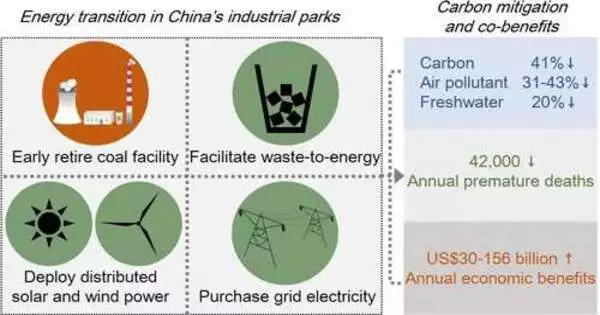Businesses that support the processing of raw materials for manufacturing and consumer goods make up the industrial sector, which is a major contributor to greenhouse gas emissions and has proven difficult to decarbonize. A lot of the industrial sector in China is organized into “parks,” which have been designated as areas where concentrated industrial activities can take place. More than 2,500 industrial parks in China currently rely heavily on coal for power. According to the findings of a recent study that was carried out under the direction of researchers from Princeton University, this clustering of industries provides one-of-a-kind and often overlooked opportunities for concentrating efforts to reduce emissions from the energy supply.
The article, which was published in the journal Environmental Science and Technology, looks at how specific decarbonization solutions that are available to Chinese industrial parks can help China and the rest of the world get closer to net-zero goals while also saving freshwater and improving health.
Yang Guo, the lead author and associate research scholar at Princeton’s School of Public and International Affairs’ Center for Policy Research on Energy and the Environment, stated, “Industrial parks can be a pioneer for low-carbon policies in practice.”
“A clean energy transition in industrial hubs has the potential to provide significant environmental, health, and economic benefits,”
Denise Mauzerall, a corresponding author of the study.
Studying 850 industrial parks, the group of five engineers and policy experts from Princeton and colleagues from several Chinese universities and industries discovered that these hubs could meet their energy needs and reduce greenhouse gas emissions by 40% by utilizing a combination of grid electricity and on-site green power.
The study’s decarbonization scenario for industrial park energy supply was based on China’s current energy policies, which include eliminating coal, increasing onsite solar and wind energy use, and increasing energy recovery from waste incineration. Their decarbonization scenario also includes additional grid-generated electricity and heat from on-site natural gas plants to fill any energy supply gaps.
The authors then estimated the carbon and air pollutant emissions and freshwater consumption of each of the 850 industrial parks to determine the benefits of their proposed decarbonization strategy. Air pollution levels were based on a baseline from 2030, and mitigation scenarios for emissions from industrial parks were calculated using a regional air quality model. The researchers then compared a baseline 2030 industrial park mitigation pathway that retires fossil fuel facilities on a regular schedule (such as a 30-year lifespan for coal-fired facilities) with their proposed 2030 industrial park mitigation pathway, keeping emissions from all economic activities (except industrial parks) constant.
After accounting for onsite emission reductions that are partially offset by emission increases from increased grid electricity and natural gas usage, the researchers discovered that the proposed mitigation pathway reduces greenhouse gas emissions by approximately 40% overall. 7 percent of China’s total emissions in 2014 came from this. Additionally, freshwater consumption decreases by approximately 20%, with the greatest reduction in water stress occurring in the provinces with the fewest resources. In addition to these advantages, the net reduction in exposure to air pollution that follows will save the lives of approximately 42,000 people by 2030. Last but not least, the authors estimated that China would gain between $30 billion and 156 billion dollars in net economic benefits by 2030 as a result of decarbonizing its industrial parks and preventing premature deaths.
Denise Mauzerall, a Princeton University faculty member and a corresponding author of the study, stated, “A clean energy transition in industrial hubs can provide large benefits for the environment, health, and economy.”
China’s industrial sector would avoid fossil fuel infrastructure lock-in and accelerate its green transition if it reduced its reliance on fossil fuels. The creators presume that the huge net advantages assessed by this study can assist with legitimizing the ventures and strategic interventions expected to move China’s modern parks towards a cleaner energy pathway.
Any efforts to decarbonize the Chinese industrial sector will have far-reaching benefits for international supply chain emissions because of the world’s reliance on Chinese exports.
Yang Guo, Mi Zhou, Liqun Peng, Mingwei Li, and Denise Mauzerall from Princeton University, Juhua Yang from China Huadian Corporation Ltd., Jinping Tian from Tsinghua University, and Lyujun Chen from Tsinghua University are the authors of the study.
More information: Yang Guo et al, Carbon Mitigation and Environmental Co-Benefits of a Clean Energy Transition in China’s Industrial Parks, Environmental Science & Technology (2023). DOI: 10.1021/acs.est.2c05725





